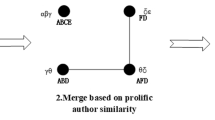Abstract
Given a project with a set of required skills, it is an important and challenging problem of find a team of experts that have not only the required skill set but also the minimal communication cost. Furthermore, in view of the benefits of greater leaders, prior work presented the team formation problem with a leader where the leader is responsible for coordinating and managing the project. To find the best leader and the corresponding team, the prior work exhaustively evaluates each candidate and the associated team, incurring substantial computational cost. In this paper, we propose two efficient algorithms, namely the BCPruning algorithm and the SSPruning algorithm, to accelerate the discovery of the best leader and the corresponding team by reducing the search space of team formation for candidates. The BCPruning algorithm aims at selecting better initial leader candidates to obtain lower communication cost, enabling effective candidate pruning. On the other hand, the SSPruning algorithm allows each leader candidate to have a lower bound on the communication cost, leading some candidates to be safely pruned without any computation. Besides, the SSPruning algorithm exploits the exchanged information among experts to aid initial candidate selection as well as team member search. For performance evaluation, we conduct experiments using a real dataset. The experimental results show that the proposed BCPruning and SSPruning algorithms are respectively 1.42–1.68 and 2.64–3.25 times faster than the prior work. Moreover, the results indicate that the proposed algorithms are more scalable than the prior work.











Similar content being viewed by others
References
Anagnostopoulos A, Becchetti L, Castillo C, Gionis A, Leonardi S (2010) Power in unity: forming teams in large-scale community systems. In: Proceedings of the 19th ACM international conference on information and knowledge management, pp 599–608
Anagnostopoulos A, Becchetti L, Castillo C, Gionis A, Leonardi S (2012) Online team formation in social networks. In: Proceedings of the 21st international conference on world wide web, pp 839–848
Backstrom L, Huttenlocher D, Kleinberg J, Lan X (2006) Group formation in large social networks: membership, growth, and evolution. In: Proceedings of the 12th ACM SIGKDD international conference on knowledge discovery and data mining, pp 44–54
Baykasoglu A, Dereli T, Das S (2007) Project team selection using fuzzy optimization approach. Cybern Syst 38(2):155–185
Buter B, Dijkshoorn N, Modolo D, Nguyen Q, van Noort S, van de Poel B, Salah AA, Salah AAA (2011) Explorative visualization and analysis of a social network for arts: the case of deviantART. J Converg 2(1):87–94
Chen SJ, Lin L (2004) Modeling team member characteristics for the formation of a multifunctional team in concurrent engineering. IEEE Trans Eng Manag 51(2):111–124
Fitzpatrick EL, Askin RG (2005) Forming effective worker teams with multi-functional skill requirements. Comput Ind Eng 48(3):593–608
Freeman LC (1977) A set of measures of centrality based on betweenness. Sociometry 40(1):35–41
Gaston ME, Simmons J, desJardins M (2004) Adapting network structure for efficient team formation. In: Proceedings of the AAAI 2004 fall symposium on artificial multi-agent learning
Jackson MO (2008) Network formation. In: The new Palgrave dictionary of economics and the law
Kargar M, An A (2011) Discovering top-k teams of experts with/without a leader in social networks. In: Proceedings of the 20th ACM international conference on information and knowledge management, pp 985–994
Lappas T, Liu K, Terzi E (2009) Finding a team of experts in social networks. In: Proceedings of the 15th ACM SIGKDD international conference on knowledge discovery and data mining, pp 467–476
Li CT, Shan MK (2010) Team formation for generalized tasks in expertise social networks. In: IEEE international conference on social computing
Majumder A, Datta S, Naidu K (2012) Capacitated team formation problem on social networks. In: Proceedings of the 18th ACM SIGKDD international conference on knowledge discovery and data mining, pp 1005–1013
Pan R, Xu G, Fu B, Dolog P, Wang Z, Leginus M (2012) Improving recommendations by the clustering of tag neighbours. J Converg 3(1):13–20
Shtykh R, Jin Q (2011) A human-centric integrated approach to web information search and sharing. Hum-Cent Comput Inf Sci 1(2):1–37
Teraoka T (2012) Organization and exploration of heterogeneous personal data collected in daily life. Hum-Cent Comput Inf Sci 2(1):1–15
Wi H, Oh S, Mun J, Jung M (2009) A team formation model based on knowledge and collaboration. Expert Syst Appl 36(5):9121–9134
Zakarian A, Kusiak A (1999) Forming teams: an analytical approach. IIE Trans 31(1):85–97
Acknowledgements
The authors thank the Taiwan Ministry of Economic Affairs and Institute for Information Industry for financially supporting this research (Industry and Government Application Empirical Environment Development Project).
Author information
Authors and Affiliations
Corresponding author
Rights and permissions
About this article
Cite this article
Juang, MC., Huang, CC. & Huang, JL. Efficient algorithms for team formation with a leader in social networks. J Supercomput 66, 721–737 (2013). https://doi.org/10.1007/s11227-013-0907-x
Published:
Issue Date:
DOI: https://doi.org/10.1007/s11227-013-0907-x




